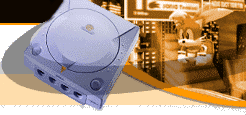| |
Evolution 2
Another dungeon, another coma. - Review By Mr. Domino
 When the Dreamcast first launched, its lineup was heavy with arcade
games. RPG gamers clamored for a lengthy quest, and Ubi Soft attempted to answer
the call by bringing over Sting's Evolution: The World of Sacred Device.
Evolution centered around the Launcher household, a family of famous
adventurers who were seriously in debt. With the aid of butler Gre Nade
and friend Linear Cannon, the young Mag Launcher took jobs excavating
ruins to uncover treasure to sell in order to pay off his family's debt. Despite
the original's shallow story (involving a general's attempts to kidnap a
young girl), the game was a nice first attempt by Sting at making a Dreamcast
dungeon crawl. Although not exactly the kind of game
RPG fans were craving for, Evolution was still the only game in
town at the time, leading many people to purchase the game
despite the availability of better RPGs elsewhere.
When the Dreamcast first launched, its lineup was heavy with arcade
games. RPG gamers clamored for a lengthy quest, and Ubi Soft attempted to answer
the call by bringing over Sting's Evolution: The World of Sacred Device.
Evolution centered around the Launcher household, a family of famous
adventurers who were seriously in debt. With the aid of butler Gre Nade
and friend Linear Cannon, the young Mag Launcher took jobs excavating
ruins to uncover treasure to sell in order to pay off his family's debt. Despite
the original's shallow story (involving a general's attempts to kidnap a
young girl), the game was a nice first attempt by Sting at making a Dreamcast
dungeon crawl. Although not exactly the kind of game
RPG fans were craving for, Evolution was still the only game in
town at the time, leading many people to purchase the game
despite the availability of better RPGs elsewhere.
As a big dungeon-exploration fan, I enjoyed the first Evolution and
thought it was a charming, if problematic, spin on the old sword and
sorcery bit. Now, only seven months later, we have before us Evolution 2: Far Off
Promise. Considering the quick development of the sequel and
the returning cast, players will surely expect more of the same. And that's
exactly what they'll get with this sequel. With the recent release of Silver and several "big" Dreamcast RPGs looming in the next few months, Evolution 2 finds itself having to prove itself worthy against a field of stiff competition. Is the new Evolution good enough to entertain RPG fans this time around?
The Good

Most of the old cast is back for more. |
Evolution 2 is more evolutionary than revolutionary, as it merely upgrades
many aspects of the original. The graphics are cleaner and a bit more detailed, but are for
the most part the same. Enemies now look better than the cheesy-looking
jointed rats that festered in the first game (and which you can still
check out in E2's fifty level practice dungeon.) There is also a new "behind the character" view a la Tomb Raider, and, while a nice extra, it is no where near as
versatile and user friendly as the standard overhead perspective.
There are more cut scenes this time around, but like in the original, these only appear after
conquering a dungeon. The main town is somewhat better-developed this time around, and there's even a second town (of sorts) this time around. However, the neatest thing about E2 is that the characters actually talk, and in a move that's sure to impress
anime fans across the country, Ubi Soft left in the Japanese voices and used subtitles.
The quality of the translation and subtitles is wonderful, and no longer must we be forced to endure "Naolin you have found" and the other grammatical inconsistencies which plagued the first game.
Other nice touchs include being able to save anywhere outside of a dungeon,
and being able to purchase an Escape Essence which will let your party escape from most

The simple, straightforward battle system returns from the first game. |
any dungeon. However, you'll pay a price if you forget to
purchase an Escape Essence before entering a dungeon, because the exit portals that appeared every five levels in the original game are no longer present in this sequel.
The battle system is still as quick and user friendly as it was in the
original, although several of the characters' more powerful attacks have
been neutered drastically. You are still free to take any of three
positions on a grid (forward to strengthen your attack power; backward to
increase your defense) and you once again regain FP (magic points) every time you attack. Each character
has a laundry list of special moves available to utilize, and Cyframe
users (characters which attack with ancient weapons attached to their
bodies) can swap these weapons with newly found ones as desired. Evolution
2's cast consists of six characters, and those not currently used in
your three person party still earn equivalent experience points so that
they do not become completely useless later on from earlier neglect.
Lastly, the dungeons are a bit more interactive this time around. Mag can punch pillars and stone blocks to reveal treasure chests or enemies. There are icy, slippery floors and conveyor
belts which make the individual dungeons stand out more than they did in the
first game, although they're ultimately just window dressing.
You're still just traveling down extremely long corridors, entering a
large room, and repeating until you find and climb enough sets of stairs
to meet up with the boss. Still, at least they tried to inject a little variety into the proceedings.
Next: The Bad and The Final Word

|

